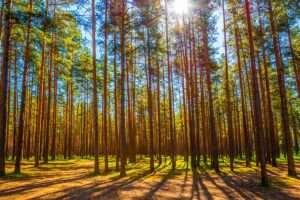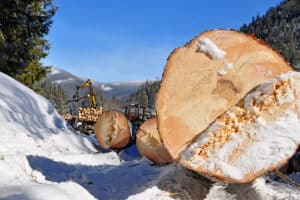While the general public’s understanding of wood bioenergy remains incomplete, recent reporting on the issue fails to meaningfully inform readers on the status of woody biomass supplies and the actual development of wood bioenergy markets in the U.S. Articles from major media outlets continue to deliver stories that suffer from failing to provide context; improperly assigning “causal” relationships; and errors of fact.
How Much Wood Would a Woodchuck…?
For example, Roger Harrabin of the BBC, in a March 5, 2013 article “Biofuels: MPs to Consider Subsidies for Power Stations” about potential subsidies for using wood at power stations in the UK, reported that power producer Drax plans to convert approximately half of the boilers at its coal-fired power station in Yorkshire to wood pellets. Harrabin notes that this would “burn more wood than the entire output from the UK’s timber industry.” And how much wood would that be?
This took four minutes to track down and summarize using the online “ForesSTAT” database from the United Nations. The UK produced one-half of one percent of the world’s industrial timber in 2011. The U.S. timber industry is 32 times bigger. EU timber production is over 38 times bigger. This failure to provide context for UK’s timber industry is like reporting on hamburger sales in India or breweries built by BYU graduates. While these could prove interesting, the numbers may prove trivial.
Call Me Maybe
On Tuesday May 28, 2013, the Wall Street Journal published a front page story related to wood bioenergy markets that managed to score the trifecta and feature three common errors appearing in media reports related to wood and timber industries. Posted online on May 27th, the article, “Europe’s Green-Fuel Search Turns to American’s Forests” by Justin Scheck and Ianthe Jeanne Dugan contains factual errors, fails to provide context or measures of scale, and improperly implies causal relationships. Ugh. Examples include:
- The article does not scale UK demand to the U.S. forest industry. During normal economic conditions, the U.S. forest industry consumes ~500 million tons of wood per year. Currently, the U.S. is exporting on the order of 2 million tons of pellets per year.
- “….Europe doesn’t have enough forest to chop for fuel…” Not true. Europe has 25% of the world’s forests. While the article notes that “many restrictions apply” to Europe’s forests, it does not question the quality, usefulness or soundness of these restrictions. The bottom line is that Europe may actually have enough wood, but chooses not to use it.
- “Many of the pellet-making plants springing up in the U.S….are near pine plantations established long ago partly to serve the now-slumping wood-pulp market.” The reference to the “slumping” pulp market is factually incorrect and easily knowable. This is a critical miss because the U.S. pulp and paper mills dominate the market for the low valued wood raw materials of interest to wood pellet producers.
Conclusions
In forestry, a natural tension exists between the unfettered exercise of private property rights and the biodiversity preferences of third-party conservation groups. This “tension” is important. Market incentives help ensure that private forests remain productive and forested, while spotlights on best management practices that protect soil integrity, water quality and wildlife habitat support long-term forest health. This tension, like a tug of war, puts someone in the mud once in a while. Sometimes a landowner cuts trees you might not cut, and sometimes states or groups seek a rule that restricts private property owners in an unreasonable way. That is part of the back-and-forth.
Wood bioenergy in the U.S. faces limits to growth. No one will be vacuuming U.S. forests to feed UK power plants. The economics, logistics and sustainability of such strategies fail on multiple levels. This is why markets in other regions such as South America, Russia and Canada continue to scale up capacity. The facts, context and market relationships highlight a stuttered, evolving wood bioenergy market in the U.S. that continues to feel its way forward as part of the large, established wood-using forest industry.
This content may not be used or reproduced in any manner whatsoever, in part or in whole, without written permission of LANDTHINK. Use of this content without permission is a violation of federal copyright law. The articles, posts, comments, opinions and information provided by LANDTHINK are for informational and research purposes only and DOES NOT substitute or coincide with the advice of an attorney, accountant, real estate broker or any other licensed real estate professional. LANDTHINK strongly advises visitors and readers to seek their own professional guidance and advice related to buying, investing in or selling real estate.










Add Comment